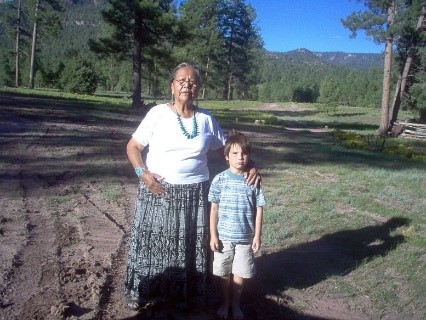RAIN CALLER
Sometimes you do what you need to do without knowing what you need to do. That was the case on a blisteringly hot summer day in Santa Fe in 1995. Temperatures were over 100 and we had been suffering from a long dry spell with no relief in sight. Not a single cloud in the sky for weeks. It was part of an unprecedented heat wave in midwestern U.S. states during which 3,000 people died, 750 in Chicago alone. https://press.uchicago.edu/Misc/Chicago/443213in.html
I was living at 1710 Upper Canyon Road in an historic but crumbling adobe rental that had all the rough charm I could have ever wanted. The first Archbishop of Santa Fe, Lamy, was listed as the original property owner, but the rugged remoteness of the earthen cabin two miles from the downtown Cathedral might have made the place more of a retreat house than a primary residence. The fireplace was almost big enough to put whole trees in it, or so it seemed to me. There were cracks in the wood plank flooring and cracks around the weathered window frames where the adobe plaster was splintering. One day as I sat at the kitchen table with my dear black cat Mona on my lap, a chunk of wall fell out, hitting me on the forehead and narrowly missing Mona. As I sat motionless and stunned, a small dribble of blood began to snake down my face. (The photo above is from a realtor’s page after the little adobe I lived in was bought and expanded dramatically.)
But I loved the place, and it loved me back. It was a dream come true–living by an acequia (irrigation canal) next to the Santa Fe National Forest, dark night skies filled with an amazing quilt of sparkling stars and quiet. Many gatherings of friends and welcome strangers took place there over the years–drum circles, counseling and massage therapy sessions, music making, tipi ceremonies and prayers for peace and well-being. The adobe walls were thick and on hot days, a welcome relief to the relentless sun and heat outside. On cold days it was hard to stay warm even though I covered the widows with thick plastic sheeting and fashioned my Grandma Fleming’s wool blankets into curtains.
On this particular day I had agreed to give a massage to an NMAS client who was now at my door. I was a volunteer massage therapist for the New Mexico AIDS Services program, serving people with HIV and AIDS as well as their caregivers and families. Before starting the session, I said to my client, “Rocky, I feel like I need to go outside and call the rain.” He looked at me puzzledly but joined me on the patio. “What are we supposed to do?” he asked. I had no idea, but I did bring what is called a “rainstick,” thinking that might help in some way.
A rainstick is a long, hollow tube partially filled with small pebbles or beans that has small pins or thorns arranged on its inside surface. https://en.wikipedia.org/wiki/Rainstick When the stick is upended, the pebbles fall to the other end of the tube, making a sound reminiscent of rain falling. The rainstick is believed to have been invented by the Mapuches of Chile and was played in the belief it could bring about rainstorms. It was also found on the Chilean coasts, though it is not certain if it was made by the Incas. Rainsticks are usually made from any of several species of cactus. The cacti, which are hollow, are dried in the sun. The spines are removed, then driven into the cactus like nails. Pebbles or other small objects are placed inside the rainstick, and the ends are sealed. A sound like falling water is made when the rainstick has its direction changed to a vertical position. Although it was thought to have been invented in Chile, many similar instruments can also be found in Southeast Asia, Australia and Africa, where it is often made using bamboo rather than dried cactus. Indigenous peoples of the Southwest use gourd rattles and other instruments in a similar ceremonial fashion.
For some reason, I lifted my rain stick to the sky and turned it to face the full intensity of the sun. As I turned the stick, pebbles gently creating the sound of water flowing, I asked the sun for its help in bringing rain. Pretty counter intuitive it seemed. It was Rocky’s turn to do what he thought best, then we both went inside for the therapy session.
Just as we began the massage, I thought I saw a brief dimming of light outdoors. Then again. I looked and there were a few clouds, the first in many weeks. That evening there was a wonderful rainstorm bringing much needed relief. Needless to say, I was dancing in the rain for joy.
Some days later, I spoke to a Dinè (Navajo) elder friend by phone. Annie Kahn had hosted a number of Earth Walks journeys at her hogan in Lukachukai, Arizona and I had great respect and love for this dear person who shared her wisdom with so many others.
“Annie, do you think I kind of maybe smelled or sensed the rain coming that caused me to go outside and do the rain prayer?” I asked.
I could see her shaking her finger at me in her good-natured grandmotherly way. “It sounds like you are having trouble accepting responsibility for what you did. More people should be doing this!”

